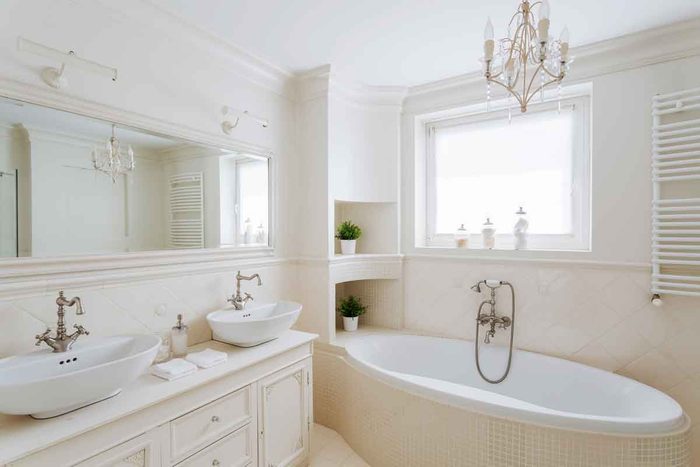Bathroom Chandeliers: What To Know Before You Buy
Updated: May 19, 2022

These trendy light fixtures don’t work in every bathroom. But when they’re right, they’re really right.
Our editors and experts handpick every product we feature. We may earn a commission from your purchases.
Bathroom chandeliers are a rising trend in home design, and we have to say they add a lot of personality and charm to a bathroom.
In a bathroom, lighting is one of the biggest design considerations. As great-looking as bathroom chandeliers are, they’re not the right choice for every bathroom. In some instances, they’re more trouble than they’re worth. And many bathrooms lack high enough ceilings to make this safe and practical.
If you’re interested in a big, beautiful, statement-making light fixture for your bathroom, keep these tips from experts in mind.
On This Page
Bathroom Chandelier Placement
Installing a bathroom chandelier is not like installing a dining room chandelier. Bathroom electrical codes are much stricter, and for good reason. With all that water, electrical work needs more precaution and precision.
Bathroom chandeliers are best suited for rooms with high ceilings. If you want to place a chandelier above the bathtub, it must be “at least eight feet above the tub,” according to Paolo Gorsini, HouseGrail consultant and a certified electrical contractor specializing in electrical installation, lighting systems and electric generators. The National Electric Code (NEC) requires the eight-foot distance.
There are different guidelines for light fixtures not placed above the tub. Peter Emmanuel Rossi, an interior designer, professional hot tub designer and founder of ByRossi, says bathroom chandeliers must be “at least three feet away from the shower, sink, or toilet. This is required for the safety and wellbeing of people in case it falls.”
Adds Gorsini: “You’ll have to be 36 inches above any tabletop if you’re putting it above the bathroom vanity.” And it should be seven feet above any seating.
However, regulations differ by state and municipality, “Before undertaking any type of electrical work,” Gorsini says, “make sure you talk with your local code authority.” Your local hardware store — or wherever you’re shopping for light fixtures — can advise if your bathroom has space for a chandelier that complies with code.
How To Choose a Bathroom Chandelier
The best bathroom chandelier will depend on the size and layout of your bathroom. “If you have a small bathroom, you want to go for something understated and small,” says Gorsini. A huge chandelier can make the space look smaller than it really is. Large bathrooms with high ceilings have endless style choices.
Before shopping, Gorsini says “(take) the measurements of your bathroom, both height and width, figure out the size you need, and then look at your options.” You can take pictures of your bathroom along on the shopping trip to find a style that matches.
If you don’t have room for a large bathroom chandelier, look for a flush mount or semi-flush mount light fixture in a similar style. The Home Depot sells a wide variety, from minimalist metal fixtures to extravagant dangling crystals.
Beyond the size and appearance, there are a few other things to consider.
“When searching for a bathroom chandelier, look for one specifically labeled ‘Suitable for Wet or Damp Locations,’ ” Rossi says. “Check your bathroom lighting zones to get a recommended IP rating.” Then, ensure your light fixtures match. There are plenty of damp-rated chandeliers on the market, from classic to boho or modern.
The way a light fixture connects to power matters, too. “You’ll need at least one wall-switched light in your bathroom that meets the NEC code,” says Rossi. Gorsini adds bathroom light sources can’t be powered by a plug-in.
Other Bathroom Light Fixture Options
A low-hanging chandelier isn’t the only way to make your bathroom lighting design stand out. Gorsini identifies three types of lighting that add ambiance, personal style and functionality.
“Vanity lights are the most popular because it is the best one for grooming,” Gorsini says. These are the lights above or beside the bathroom mirror. Wall sconces and bar lights are popular options.
“Ambient lighting is low lighting that is mounted on the ceiling,” says Gorsini. “There are a lot of choices here, too, including chandeliers.” It could also be a flush mount light or an exhaust fan with built-in lighting. Unlike vanity lights, ceiling lights brighten the whole room.
You can also use light fixtures as décor. “Accent and recessed lighting are more to accent areas in the bathroom or show off certain areas,” Gorsini says. Some examples are backlit mirrors, under-cabinet lights, cove lights and even toilet lights.